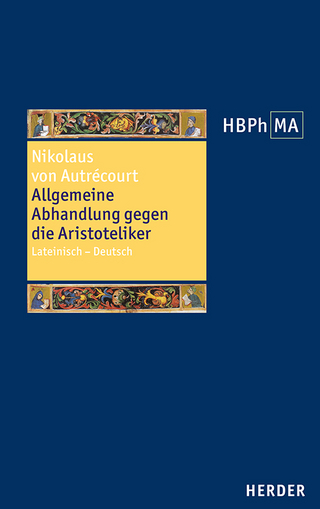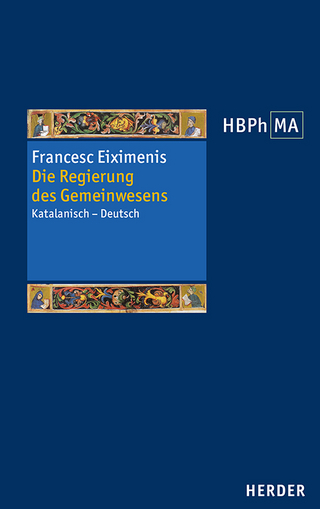
The Science of the Soul
Leuven University Press (Verlag)
978-90-5867-930-7 (ISBN)
- Titel z.Zt. nicht lieferbar
- Versandkostenfrei
- Auch auf Rechnung
- Artikel merken
The transformation of the science of the soul between 1260 and 1360.
Aristotle's highly influential work on the soul, entitled De anima, formed part of the core curriculum of medieval universities and was discussed intensively. It covers a range of topics in philosophical psychology, such as the relationship between mind and body and the nature of abstract thought. However, there is a key difference in scope between the socalled ‘science of the soul', based on Aristotle, and modern philosophical psychology. This book starts from a basic premise accepted by all medieval commentators, namely that the science of the soul studies not just human beings but all living beings. As such, its methodology and approach must also apply to plants and animals. The Science of the Soul discusses how philosophers, from Thomas Aquinas to Pierre d'Ailly, dealt with the difficult task of giving a unified account of life and traces the various stages in the transformation of the science of the soul between 1260 and 1360. The emerging picture is that of a gradual disruption of the unified approach to the soul, which will ultimately lead to the emergence of psychology as a separate discipline.
This publication is GPRC-labeled (Guaranteed Peer-Reviewed Content).
Sander de Boer is Postdoctoral Researcher at the University of Groningen (Faculty of Philosophy). He works mainly on the history of philosophical psychology.
Acknowledgements
Abbreviations
Chapter 1: Introduction
1.1 Subject matter
1.2 Status quaestionis
1.3 Periodisation and sources
1.3.1 A chronological list of consulted commentaries
1.4 Orthography, punctuation and translations
Chapter 2: Overview
2.1 The introduction of the De anima into the Latin West
2.2 The soul as perfectio
2.2.1 Avicenna's influence
2.3 The soul as forma
2.3.1 Immortal but not personal: radical Aristotelianism
2.3.2 Formality and subsistence combined: Thomas Aquinas
2.3.3 A substance, but also a form
2.4 Unicity versus plurality of substantial form
Chapter 3: Methodologic al discussions
3.1 The scientific status of the scientia de anima
3.1.1 Imperceptibility
3.1.2 Simplicity
3.1.3 Potentiality
3.1.4 The study of the soul within natural philosophy
3.1.5 Radulphus Brito against John of Jandun
3.1.6 An increasing focus on the intellect
3.2 The subject matter of the scientia de anima
3.2.1 The soul as subject matter
3.2.2 The ensouled body sub ratione animae as subject matter
3.2.3 Leaving the subject matter undecided
3.2.4 Summary
3.3 The epistemic status of the scientia de anima
3.3.1 Unproblematic beginnings: Thomas Aquinas
3.3.2 Certitude and nobility combined: Anonymus Van Steenberghen and Walter Burley
3.3.3 Increasing difficulties: Anonymus Bazan, Radulphus Brito and John of Jandun
3.3.4 The final stages: John Buridan and Nicole Oresme
3.4 Conclusions
Chapter 4: The Aristotelian definition of the soul
4.1 Aristotle's definition of the soul
4.1.1 Thomas Aquinas's views on the matter of the soul
4.1.2 The Anonymi
4.2 Fourteenth-century interpretations
4.2.1 The substantiality of the soul
4.2.2 The actuality of the body
4.3 Can we perceive the identity of accidents?
4.3.1 Thomas Aquinas
4.3.2 Radulphus Brito
4.3.3 John of Jandun
4.3.4 John Buridan
4.4 Excursus: condemnations and polemics
4.5 Conclusions
Chapter 5: Substance, powers and acts
5.1 A curious fourteenth-century thought experiment
5.2 One soul or multiple souls?
5.2.1 John Buridan's arguments against a plurality of souls
5.2.2 Nicole Oresme's hesitation
5.2.3 Summary
5.3 The relation between the soul and its powers
5.3.1 Arguments against a real distinction
5.3.2 Arguments in favor of a real distinction
5.3.3 Some preliminary conclusions
5.3.4 The identification of the soul with its powers
5.4 The soul's presence in the body
5.4.1 From annulose to perfect animals
5.4.2 Is the soul extended or not?
5.4.3 The discussion of the soul's presence after Ockham
5.4.4 Is the power of sight really present in the foot?
5.4.5 From annulose animals to perfect animals
5.5 From animal soul to human soul
5.5.1 The intellective soul: material or immaterial?
5.6 Epilogue and conclusions
5.6.1 The fragile unity of the science of the soul
Chapter 6: Final conclusions
Bibliography
Manuscripts
Published sources
Secondary literature
Index Codicum Manuscriptorum
Index Nominum
| Reihe/Serie | Ancient and Medieval Philosophy–Series 1 |
|---|---|
| Verlagsort | Leuven |
| Sprache | englisch |
| Maße | 160 x 239 mm |
| Themenwelt | Geisteswissenschaften ► Philosophie ► Philosophie des Mittelalters |
| ISBN-10 | 90-5867-930-6 / 9058679306 |
| ISBN-13 | 978-90-5867-930-7 / 9789058679307 |
| Zustand | Neuware |
| Haben Sie eine Frage zum Produkt? |
aus dem Bereich


